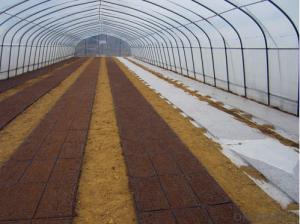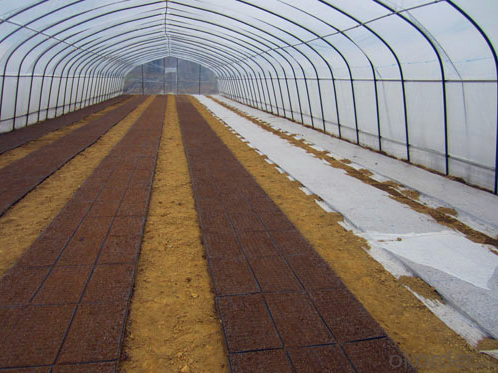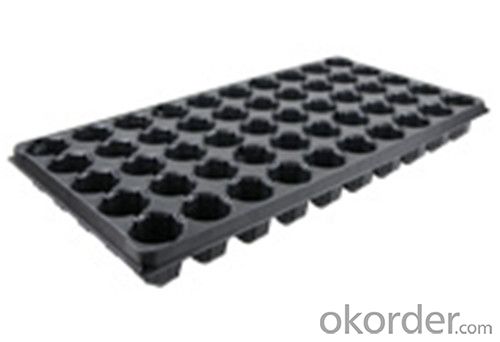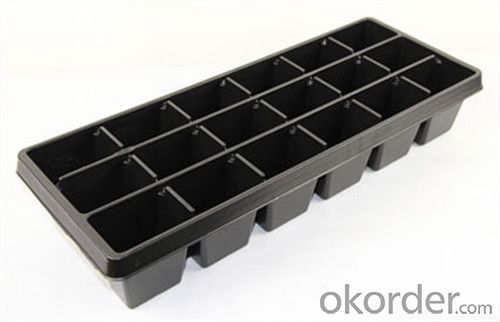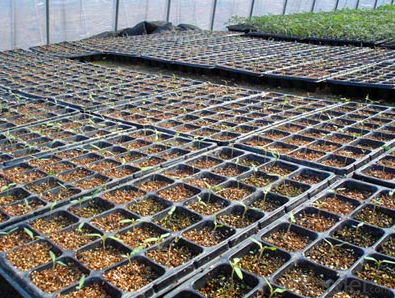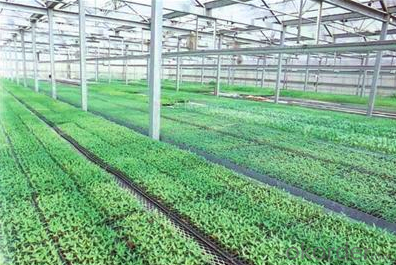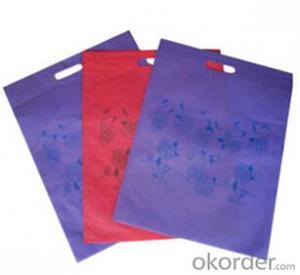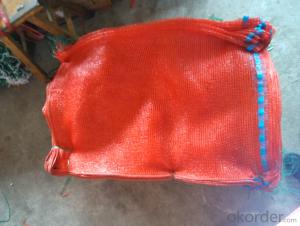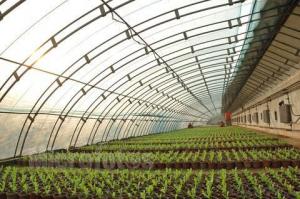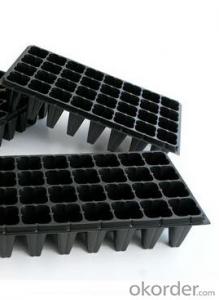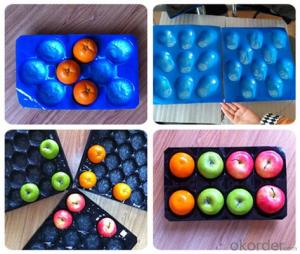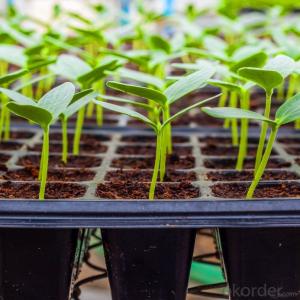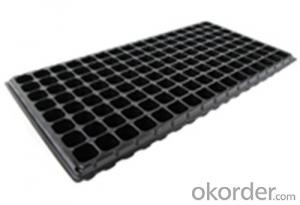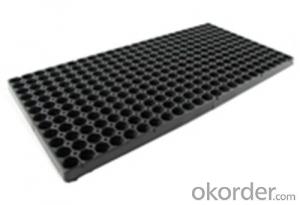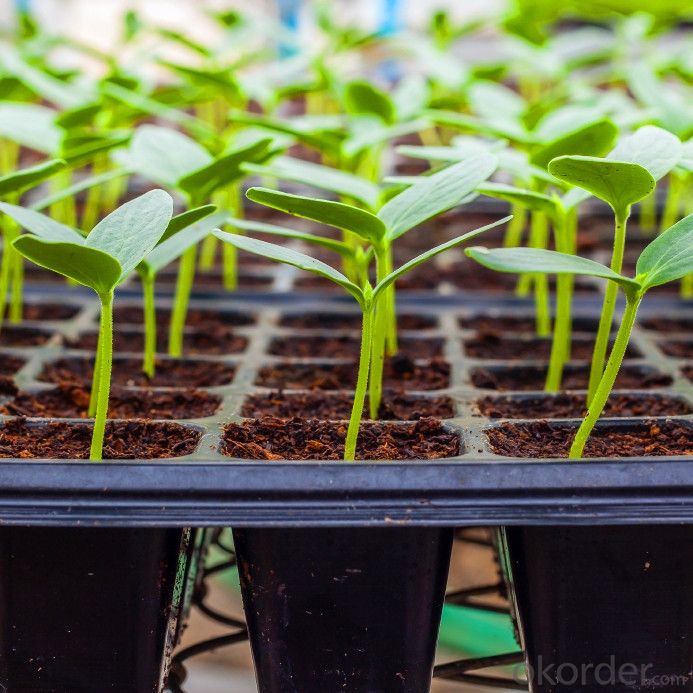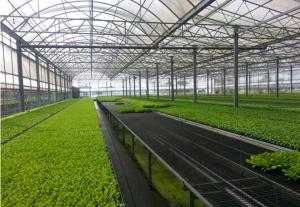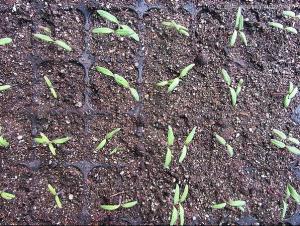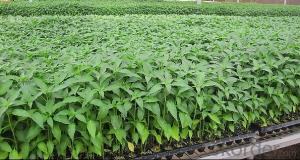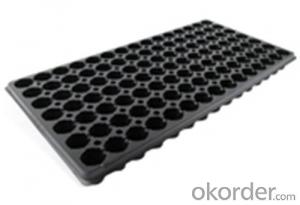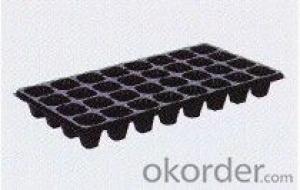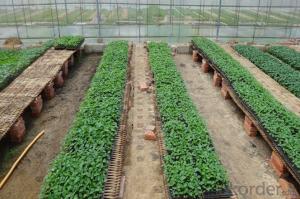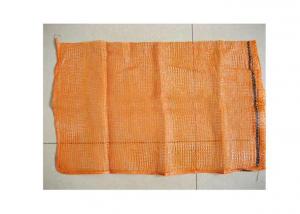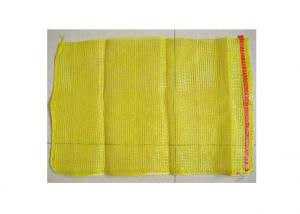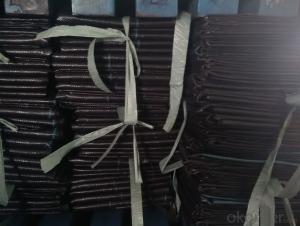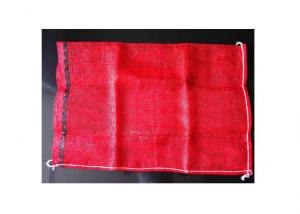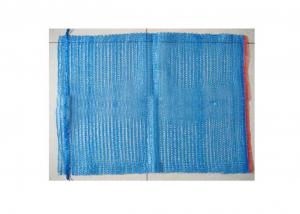Plastic Seedling tray / Plastic Nursery Seeding Tray
- Loading Port:
- China main port
- Payment Terms:
- TT OR LC
- Min Order Qty:
- 1000 pc
- Supply Capability:
- 10000000 pc/month
OKorder Service Pledge
OKorder Financial Service
You Might Also Like
Structure of the seed tray: · Top quality and competitive price. · Variety design and good appearance. · Easy to use, and remove. · Durable and reusable. · Eco-Friendly.
Advantages: · Top quality and competitive price. · Variety design and good appearance. · Easy to use, and remove. · Durable and reusable. · Eco-Friendly.
Application: · Ideal for Starting seeds and Transplanting Seedling. · Suitable for both manual and automatic planting. · Suitable for Propagating Vegetables, Flowers and other plant from seed · in green-house or indoors.
Description Main Features of the seed tray: · Ideal for Starting seeds and Transplanting Seedling. · Suitable for both manual and automatic planting. · Suitable for Propagating Vegetables, Flowers and other plant from seed in green-house or indoors. Using time: · thickness of 0.5mm can be used 1 to 2 times. · thickness of 0.6mm can be used 3 to 4 times. · thickness of 0.7mm can be used 5 to 6 times. · thickness of 0.8mm can be used 7 to 8 times. · thickness of 0.9mm can be used 8 to 9 times. · thickness of 1.0mm can be used 8 to 10 times. Thickness vs. Weight: · Thickness of trays are from 0.5mm to 1.0mm. · 1.0mm: 155g±5g; 100pcs/ctn. · 0.9mm: 140g±5g; 120pcs/ctn. · 0.7mm: 110g±5g; 150pcs/ctn. · 0.6mm: 95g±5g; 180pcs/ctn. · 0.5mm: 80g±5g; 200pcs/ctn.
Seed Tray Specification: Materialps/pvcThickness0.5mm-1.5mm, standard:1mmWeight80g(±5)g-230g(±5)g, Standard weight:155g(±5)gSizelength:490mm-540mm, width:190mm-345mm,depth:25mm-150mm Standard:54mmX28mmCell count18-512Packagein cartonUsing time8-10 times
FAQ: Q:How Can I Get A Sample? A:You can get samples by communicate with our export sales. Q:How Long Is Delivery? A:Delivery time will be 7-25 days according to order quantity. Q:What Is The MOQ? A:Our MOQ is 1*20FT container quantity, allow to mix several items. Q:What Is Our Normal Payments Terms? A:Our normal payment terms now is T/T, L/C or Western Union,Papal. Q:How Do I Order Your Products? A:You can check our website for any items you interest and you can also get communication with our export sales and order for it accordingly. Q:What Kinds Of Material We Use In Our Product? A:Our plastic flower pots use material such as PP polymer or PE polymer.
|
- Q: How do I incorporate ground cover into a xeriscape design?
- To incorporate ground cover into a xeriscape design, consider using low-growing, drought-tolerant plants that can thrive in arid conditions. Choose varieties that spread quickly, such as creeping thyme or ice plant, to effectively cover the ground and prevent weed growth. Prioritize native species, as they are well-adapted to the local climate and require less water. Additionally, make sure to prepare the soil properly by adding organic matter and mulch to improve water retention. Regularly monitor and adjust irrigation to ensure the ground cover receives adequate moisture without excessive usage.
- Q: My friend got me a plastic navel barbell, because I have a nickel allergy I thought plastic would be great. I put it in during the day and by night the top and bottom holes were BRIGHT red and pus was oozing out of it. I did change it to my old metal barbel...How is this possible?!Can someone actually be allergic to the PLASTIC?Was my body reacting to the plastic?
- complex issue. query on yahoo. this will help!
- Q: Can nursery trays be used for starting butterfly garden seeds?
- Yes, nursery trays can be used for starting butterfly garden seeds. They provide a convenient and organized way to start seeds, allowing for proper drainage and easy transplanting once the seeds have germinated.
- Q: Do nursery trays come in different colors?
- Yes, nursery trays come in different colors.
- Q: The cap of a plastic water bottle is made of thicker plastic. Is it true you can't recycle these?
- Yes, the recyclers ask that you remove them from the containers so that the containers can be crushed without damaging the steel rollers used to crush them. If you leave the caps on, the containers retain their shape till the pressure bursts the plastic thereby collapsing suddenly and the steel rollers slam together with a fair deal of force which eventually damages them. You're supposed to just remove the caps and toss the caps into the recycling bin. How this mutated into the common belief that recyclers don't want caps is simply evidence that most people don't read thoroughly and are apt to making assumptions. The sorting of plastic in a single stream recycling facility involves dropping the plastic through a laser beam which determines the type of plastic and triggers a puff of air to blow it into the appropriate bin. The caps don't represent any added separating requirements.
- Q: Types and uses of agricultural plastic products
- According to the division of agricultural plastic application areas are mainly agricultural covering materials; agricultural water supply pipeline and water saving equipment; plastic packaging materials and agricultural planting, breeding, storage with various materials.
- Q: How do agricultural plastic products help with soil erosion prevention?
- Agricultural plastic products, such as mulch films and erosion control blankets, help with soil erosion prevention by providing a protective layer on the soil surface. These products act as a barrier, preventing rainwater and wind from directly impacting the soil. This reduces the erosive forces and helps to retain moisture in the soil, promoting better plant growth and preventing the loss of topsoil. Additionally, agricultural plastic products can also help to stabilize slopes and prevent runoff, further contributing to soil erosion prevention.
- Q: When did plastics start to hit the earth?
- The pot of gold digging, Baekeland bought a seat overlooking the Hudson River near New York in Yonkers mansion, a private laboratory will be changed into the barn equipment, is also working with people built a pilot plant in Broolyn. At that time, the nascent electric power industry contained a huge market for insulating materials. The first temptation Baekeland smell is soaring price of natural shellac insulating materials, for centuries, this material has been relying on family handicraft production in South asia. After the inspection, Baekeland to find alternatives to shellac as the first commercial target. At that time, chemists have begun to realize that many used in coatings, adhesives and fabrics with natural resins and fibers are polymers, namely the repeat structure of macromolecules, began looking to compositions and methods of polymer synthesis.
- Q: This question asks about the impact of agricultural plastic films on water consumption.
- <p>Agricultural plastic films, such as mulch films, can significantly affect water usage in agriculture. They help in conserving water by reducing evaporation from the soil surface. The films cover the soil, creating a barrier that minimizes direct contact between the soil and the atmosphere, thus lowering the rate of water loss through evaporation. This conservation of water can be crucial in arid and semi-arid regions where water is a scarce resource. Additionally, plastic films can also help in maintaining soil moisture by reducing the impact of raindrop splash, which can dislodge soil particles and expose the soil to direct sunlight, leading to increased evaporation. However, it's important to note that the improper disposal of these films can lead to environmental issues, including soil and water pollution, which is a concern that needs to be managed alongside their water-saving benefits.</p>
- Q: Can ground cover be used to create a sense of privacy in a garden?
- Yes, ground cover can be used effectively to create a sense of privacy in a garden. By densely planting low-growing ground cover plants, such as creeping juniper or vinca minor, they can form a natural barrier that blocks the view from neighboring properties or passersby. Additionally, ground cover can also help to absorb sound, providing an added level of privacy and tranquility in the garden.
Send your message to us
Plastic Seedling tray / Plastic Nursery Seeding Tray
- Loading Port:
- China main port
- Payment Terms:
- TT OR LC
- Min Order Qty:
- 1000 pc
- Supply Capability:
- 10000000 pc/month
OKorder Service Pledge
OKorder Financial Service
Similar products
Hot products
Hot Searches
Related keywords
